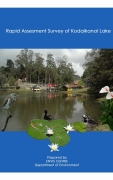Biodiversity
The First Indian Biodiversity Congress (IBC) 2010, CISSA, Thiruvananthapuram
Posted on 01 Oct, 2010 02:04 PMIndian Biodiversity Congress (IBC) 2010
Theme: Biodiversity and Development: Mainstreaming Biodiversity into Policy-Making
Water security vs national security published in Third Concept September 2010 : Countries that share a river face a higher probability of engaging in military disputes
Posted on 28 Sep, 2010 10:15 AMThere has been growing public and policy preoccupation in recent years with potential climate impacts on water security in the wake of the worsening risk of global warming. In 1991, then–UN secretary general Boutros Boutros-Ghali pronounced that “the next war will be fought over water, not politics.” In 2001, Kofi Annan warned that “fierce competition for fresh water may well become a source of conflict and wars in the future.” And present UN secretary general Ban Ki-Moon has argued that the ongoing Darfur crisis grew at least in part from desertification, ecological degradation, and a scarcity of resources, foremost among them water. Apart from this chorus of concern, many policy scholars have asserted that, as population growth and economic development raise pressures on demand and environmental pressures degrade supplies, resource scarcities could precipitate violent international conflicts, with shared rivers an especially dangerous flashpoint.
Importance of groundwater – A presentation by ACWADAM
Posted on 22 Sep, 2010 08:03 PMThis presentation by ACWADAM deals with the importance of groundwater. It is well-known fact that groundwater forms a very crucial source of water supply in the national scenario on water resources today. And yet, it continues to remain a resource that is both abused and misused. Often, watershed projects suffer from insufficient inputs, especially hydrogeological to address the problem(s) of groundwater within the watersheds.

Earth System: Interactions Part II – A presentation by ACWADAM
Posted on 20 Sep, 2010 06:43 AMThis presentation by ACWADAM on earth system deals with the interactions between the four elements that make up this system. The complexity of the earth system, in which spatial and temporal variability exists on a range of scales, requires that an organized scientific approach be developed for addressing the complex, interdisciplinary problems that exist.
Earth System: Introduction (Part I) - A presentation by ACWADAM
Posted on 19 Sep, 2010 07:00 PMThe presentation by ACWADAM on earth system deals with the four elements that make up this system. Earth science generally recognizes four spheres, the lithosphere, the hydrosphere, the atmosphere, and the biosphere; these correspond to rocks, water, air, and life. These four interdependent parts or the earth's spheres are described as:
- the lithosphere, which contains all of the cold, hard, solid rock of the planet's crust (surface), the hot semi-solid rock that lies underneath the crust, the hot liquid rock near the center of the planet, and the solid iron core (center) of the planet
- the hydrosphere, which contains all of the planet's solid, liquid, and gaseous water,
- the atmosphere, which contains all of the planet's air, and
- the biosphere, which contains all of the planet's living organisms.
Seeds of Hope – Agriculture and Food Security - A Lokayan and Planning Commission study
Posted on 05 Sep, 2010 10:37 PMThis set of case studies is a part of a book prepared by Lokayan in collaboration with the Planning Commission titled “Seeds of Hope", covering themes of agriculture, biodiversity, education, forestry, governance, health, movements and water. The case studies related to agriculture and food security are summarised below:
Inviting public opinion on Western Ghats ecology - Ministry of Environment and Forests (Government of India)
Posted on 22 Aug, 2010 01:41 PM
How would we judge ecological sensitivity? Scientists view an ecologically sensitive area as an area whose ecological balance, once disturbed, is very hard to restore. Thus, steep Western slopes of Western Ghats, subject to heavy rains and winds, if deforested, are likely to be quickly stripped of soil cover and for ever lose their pristine vegetation. We do have a scientific understanding of the environmental attributes that render areas more sensitive; we also have insights into processes that have resulted in irreversible ecological damage.
Appeal to save Ramsar site - Kol wetland, Kerala
Posted on 17 Aug, 2010 03:28 PMAmayam island in Kololambu, Edappal panchayath, Malappuram ditstrict, Kerala state which have rich in biodiversity and 40 acres of kol wet land is around the island is also rich in its rare biodiversity. This kol wet land is a part of vembanad backwaters (13,632 hectors) and declared as RAMSAR SITE (No. 1214) in 2002.
Floods, drinking water contamination, mining and waterbodies, water bills, water conflicts - News roundup (1-7 August 2010)
Posted on 07 Aug, 2010 04:51 PMFloods: lessons to be learnt from the massive flooding in Surat city
A report by IIM criticises the way in which dams are managed in the country and calls for the need to apply Management Science / Operations Research techniques and information technology to improve dam management and prevention of floods
Rapid assessment survey of Kodaikanal lake - ENVIS Centre (TN) (2009)
Posted on 02 Aug, 2010 02:02 AM This document by the Department of Environment, Government of Tamil Nadu highlights the importance of the Kodaikanal lake as an important tourist destination and warns that this freshwater lake is under the threat of getting polluted and its biodiversity endangered.
This document by the Department of Environment, Government of Tamil Nadu highlights the importance of the Kodaikanal lake as an important tourist destination and warns that this freshwater lake is under the threat of getting polluted and its biodiversity endangered.
The document presents the findings of the study that aimed at assessing the physico-chemical and biological quality of the Kodaikanal lake.
Evidence indicates that unrestricted tourism activities have led to high use of plastic bottles, glass bottles, plastic bags, causing high levels of pollution and silting of the lake. Damaged fibreglass boats left inside the lakes also pose a serious threat to the lake ecosystem.







